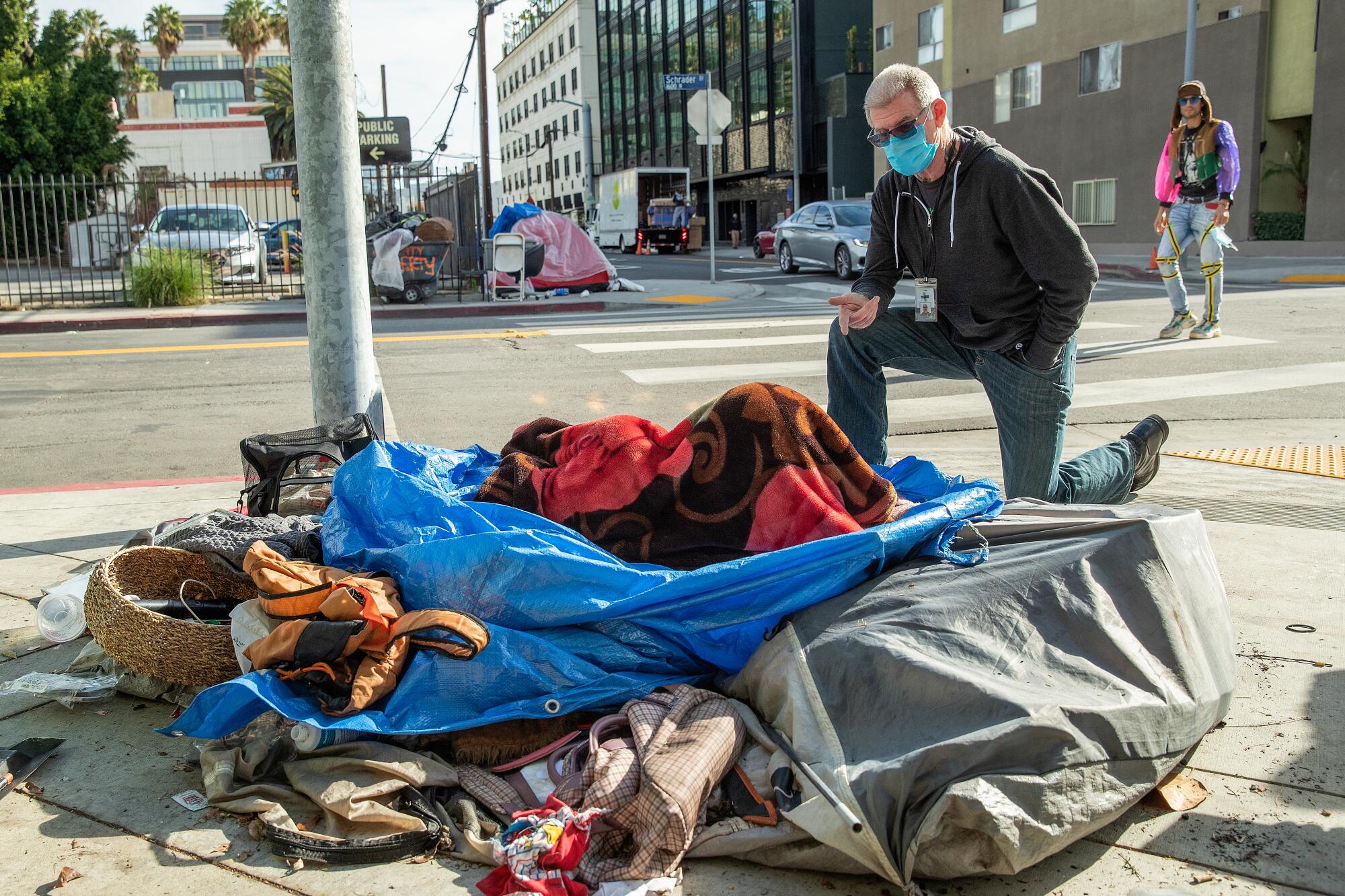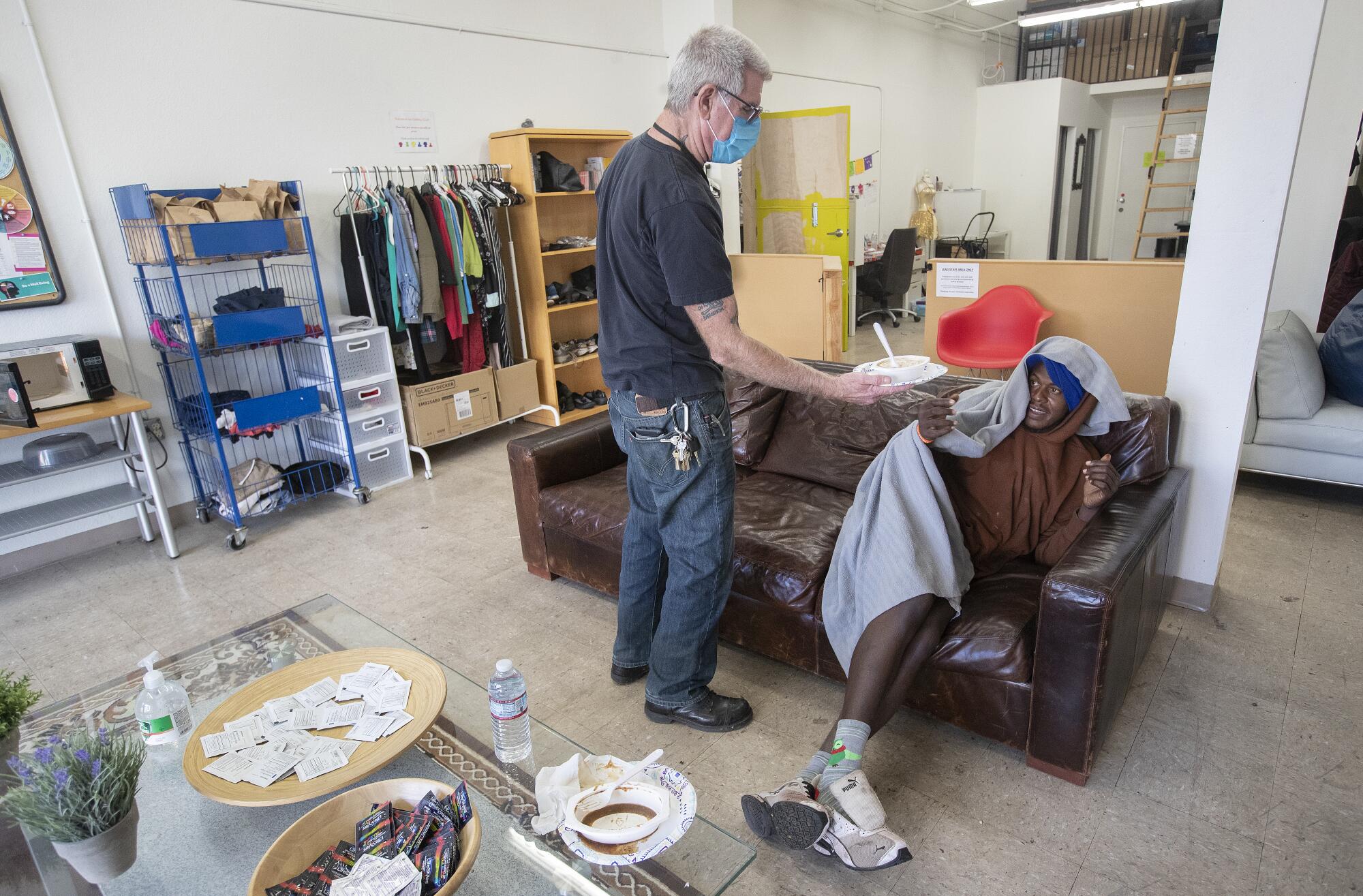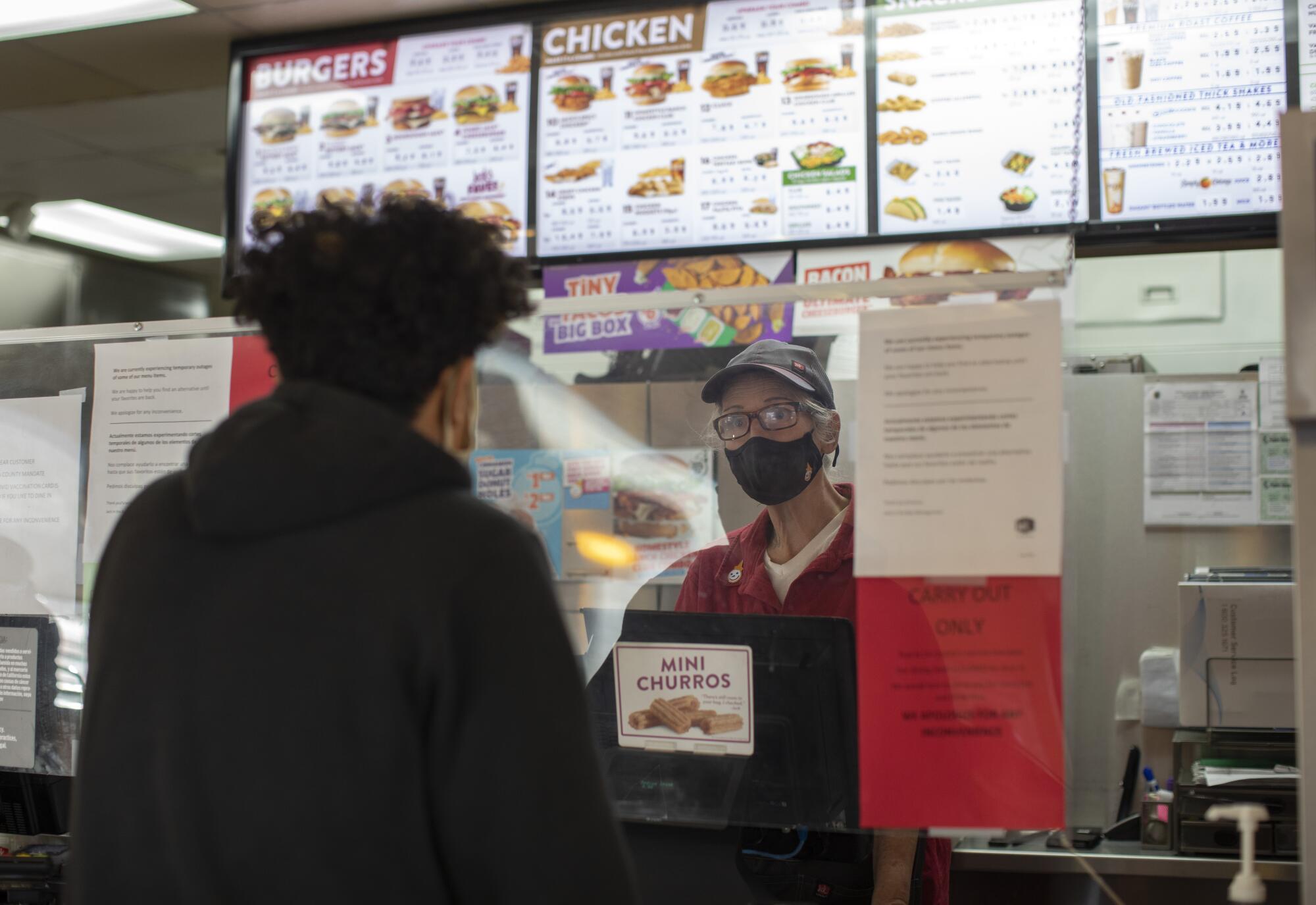
- Share via
It was a brisk and gray Friday when Jason Sodenkamp parked his weathered Nissan Altima under a freeway overpass in East Hollywood and headed to meet the man he called Lucifer.
Lucifer had been his client for a few years after police officers referred the blue-eyed man with the devilish nickname to a program meant to keep him from heading back to prison. Its name was the Law Enforcement Assisted Diversion program, but Sodenkamp puts it more plainly with new clients: He’s going to help them get stuff done that they want to get done.
For Lucifer, that was getting an ID, something he hadn’t had for nearly two decades. Next he hopes it might be housing. In the meantime, Sodenkamp brings Lucifer clean syringes and boxes of naloxone — medication to reverse an opioid overdose — and asks what else he needs.
“He’s the only one that gets me positive input,” said Lucifer, who gave only his nickname, holding court outside an encampment draped with tarps. “It’s easy to give up out here. It’s harder to stick it out.”
Under the LEAD program, which was first launched in Seattle and has now been operating five years in Los Angeles, case managers meet regularly with people who have repeatedly tangled with the criminal justice system due to minor drug offenses or sex work — or are at risk of doing so — and try to keep them healthier, safer and free.
The goal is to address unmet needs that push people toward crime and arrests and instead nudge them toward supportive services. It has aided more than 400 people so far in Los Angeles County with programs operating in Hollywood, the South Los Angeles/North Long Beach area, and East Los Angeles.

In Hollywood, the work is being done by Community Health Project L.A. Its case managers check in with clients in tents and under freeways; drive them to the hospital and court hearings; help them through the gantlet of paperwork for government benefits, healthcare and housing; and tend to other day-to-day needs.
Yatorion Jackson recounted that one time, he overslept for a court hearing, panicked and ran out of the abandoned house where he was living to chase down the bus.
Outside, he found his case manager, Jenna Kacy, waiting to drive him to the courthouse. “She was like, ‘I’ve been sitting out here waiting for you!’” Jackson recalled.
In years of being unhoused, Jackson said, he had never signed up for food stamps or gotten payments through the general relief program. Kacy helped arrange them for him. He had no ID. Kacy helped him get one and kept it safe so it wouldn’t be lost on the streets.

Without her, “I’d be in jail. Probably prison by now,” Jackson said. He is still unhoused, but he makes a point of buying a meal from Roscoe’s House of Chicken & Waffles for her. “I just do it out of appreciation.”
Kacy is a little uncomfortable with the gifts but has learned not to argue. “The first time I didn’t quite understand what he was doing,” she said. “He just asked if I could stop so he could get something to eat.”
When Jackson first became her client, Kacy said, he didn’t seem to want much from her. She brought him bags of food and supplies. Sometimes she would ask if he wanted to go to the doctor, Kacy said. He turned her down.
Then one day he called her from the hospital, asking for help. She couldn’t come in to visit because of COVID-19 restrictions, but she brought him a phone charger and candy.
“You just show up and show up,” she said.
A USC researcher is still assessing results at the Hollywood site, but a Cal State Long Beach evaluation found that after a year, people participating in the South L.A./North Long Beach program were much less likely to get arrested for misdemeanors or felonies than a comparable group. They were also less likely, after enrolling, to report being sexually assaulted or physically attacked.
Police officers, community groups and others can refer clients to the Hollywood program, which got initial funding from the U.S. Department of Justice and has been sustained with state and county funding, operating on an annual budget of roughly $1 million. Its partners include the Los Angeles Police Department, the Office of Diversion and Reentry within the county health services department, and the offices of the district attorney and the city attorney.

As he was beginning his day that Friday in Hollywood, Sodenkamp stopped on Selma Avenue and found another client under a heap of blankets on a street corner, cradling her Chihuahua puppy under its cover.
The woman badly needed new clothes after the December rains. “You want everything, right? Pants, socks, shirts, hoodies?” Sodenkamp asked, kneeling on the sidewalk.
He checked that she had gotten her flu shot and her COVID-19 booster shot and suggested that they start trying to find housing for her — maybe get her into their office soon to sit down in front of a computer and make appointments. “You need anything else?” he asked her. “I’ll be back this afternoon with clothes.”
Chad Roye, who has been in the program for years, credits Sodenkamp with getting him a Section 8 voucher and an apartment. There was a hernia that had pained him for years; with help from Sodenkamp, he got surgery. And off the streets, he can finally take his HIV medication regularly like he’s supposed to, instead of losing it to theft.
After decades on the streets, “trust is not one of my things,” said Roye, 48. “But Jason never lied to me. Never did anything wrong. I pretty much trust him more than anybody.”
Sodenkamp thinks it helps that he had “an upbringing in drug culture.” Even if he never brings it up, Sodenkamp believes his clients can sense that about him.
“I ran the streets in Hollywood in the ‘80s” and was raised as a child of the 1960s by parents who were involved in “the non-peace-and-love side of drug sales,” Sodenkamp said.
He likened his job to sales. He has sold stuff before. Tools for machine shops. Subscriptions to the Los Angeles Times. The philosophy of sales, he said, is that everyone wants to buy things — all you have to do is help them make the decision.
“They want their life to be better. It’s a no-brainer. All I’m doing is getting them to say, ‘Yes,’” Sodenkamp said. He gave an example: “You want to feel better, right? Yeah. You do want to have healthcare, right? Yeah. So you do want to come to the Saban [Community] Clinic with me on Thursday, right?”

Just like with selling anything, “you build a relationship of trust with somebody until they believe you’re not going to screw them on this product,” Sodenkamp concluded. This time, though, “they’re the product.”
Sodenkamp added that if going to a health clinic is a sales pitch, drug treatment is an upsell. He asks clients if they want to go into treatment to abstain from drugs, and if not, if they might want to use them less.
The LEAD program is rooted in the philosophy of harm reduction, which aims to help people be healthier and safer even if they are still using drugs. For instance, the program offers clean needles to avoid deadly infections and supplies clients with naloxone to reverse opioid overdoses. Although such programs do not demand abstinence, harm reduction advocates argue that providing practical help builds trust so that drug users will reach out for support if they do want to get sober.
The Cal State Long Beach evaluators found that at the South L.A./North Long Beach program, more than two-thirds of LEAD participants said they had stopped or cut back on drug use after enrolling.
“My life is a hot mess,” said Lori Castro, 59, before quickly correcting herself. “It was a hot mess. Not anymore.”
Castro said she had been using drugs off and on for three decades — first heroin, then meth — and spent her nights roaming the streets to find cans and bottles to recycle for cash. She slept in her BMW sedan, then under bridges and freeways. She became wracked with paranoia. Sometimes she would scream at a church near the Community Health Project offices.

“She was such a tornado,” Kacy, who serves as her case manager, recalled. “I would drive and she’d stick her head out the window and yell at people as we’re driving to a doctor’s appointment.”
After police connected Castro with the program, she became a fixture at its Hollywood drop-in center to nap on the couch and charge her phone. When she was hungry, they fed her — “Jenna,” she asked Kacy, “how many Top Ramen soups have you made me?” — and she could also turn to its Western Avenue office for clothes, fresh socks and shoes, and clean needles.
“They’re about, ‘If you want to use, we’ll give you safe, alternative ways to use,’” Castro said. “Nobody else does that.”
When she phoned Kacy, she was often screaming, the case manager recalled. Sometimes Castro would get frustrated, or they both would. Castro would say, “‘I’m quitting, I don’t want to work with you anymore,’” Kacy recalled.
“And then I’d call the next day and say, ‘Do you want a ride to that appointment?’”
Castro said she ultimately decided she had to quit drugs after having “a near-death experience.” When she did, she turned back to Kacy and a medical clinic that had helped her. They got her into a sober living home in Palmdale, where she became head resident.
“I didn’t mess up. I didn’t relapse,” Castro said proudly.
In December, one of her friends who worked in a pizzeria brought her a pizza with a “9” made out of pepperoni to celebrate nine months of sobriety. She has a job now as a cashier at Jack in the Box.
“The customers there love me,” she said. “And I love that. That I’m able to make somebody smile.” What she wants to do, someday, is become a case manager like Kacy.

Kacy said what she has learned, from working with both Castro and Jackson, is that “even when you think you’re making no progress ... something is happening. Just by constantly showing up.”
Sodenkamp spent part of his Friday scaling a ragged slope of turf that overlooks the 101, trying to find another client and give him his birth certificate. “He needs that to get his Cal ID. He needs his Cal ID to get his Social Security card. If he doesn’t have that, he’s never going to get a housing resource,” Sodenkamp explained.
He clambered up the slope, dirt skidding from his heels, and spotted smoke. It was a small fire, with no one anywhere to be seen. He heaped dirt to put out the flames as a group of firefighters trudged up from below.
One crisis averted, Sodenkamp headed down the incline and eyed the underpass scrawled with neon musings such as “City of Angels” and “Punk Isn’t Dead.” He got back behind the wheel and went on looking for his client.
More to Read
Sign up for Essential California
The most important California stories and recommendations in your inbox every morning.
You may occasionally receive promotional content from the Los Angeles Times.














